Standing at the edge of a steaming geyser basin, I’m reminded why this national park feels like Earth’s living diary—every trail whispers ancient stories. Yellowstone isn’t just a destination; it’s a conversation between fire and ice, meadows and mountains. Planning your adventure here demands equal parts wonder and wisdom.
From charting geothermal spectacles like Old Faithful to navigating backcountry routes, every choice shapes your experience. I’ve learned that the best itineraries balance iconic landmarks with hidden gems—like watching bison graze at dawn or finding solitude in Lamar Valley. The park’s vastness rewards those who prepare but surprises even seasoned explorers.
What makes a successful trip Yellowstone veterans would applaud? Anticipating weather shifts, securing permits early, and leaving room for spontaneity. Whether you’re chasing waterfalls or stargazing at 8,000 feet, this guide will help you craft moments that linger long after your boots dry.
Key Takeaways
- Yellowstone’s landscapes blend geothermal wonders with diverse wildlife habitats
- Strategic planning balances must-see sites like Old Faithful with off-trail discoveries
- Weather preparedness and permit logistics are crucial for smooth adventures
- Local insights enhance opportunities for wildlife viewing and unique experiences
- Flexibility allows for spontaneous moments in the park’s ever-changing environment
Understanding Yellowstone National Park
The park’s sprawling terrain—shaped by ancient volcanic forces—unfolds like a living geology textbook. Covering 2.2 million acres across three states, this national park reveals new perspectives at every turn. Five main entrances act as gateways to distinct ecosystems, from the steaming Norris Basin to the wildlife-rich Hayden Valley.
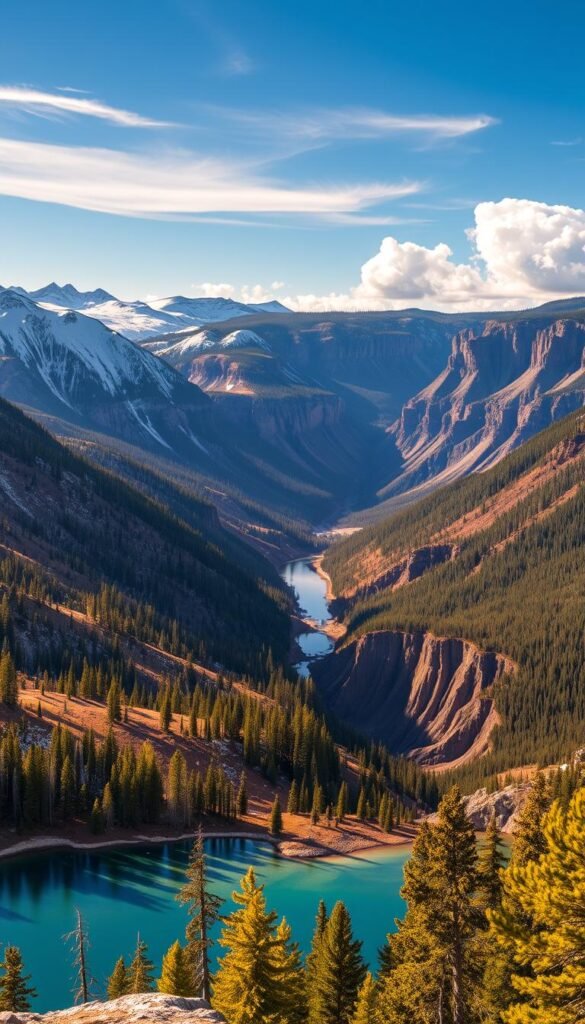
Nature’s Blueprint
Yellowstone sits atop a supervolcano, its landscape constantly reshaped by geothermal activity. The Grand Loop Road forms a figure-eight through the heart of the park, connecting major zones:
| Entrance | Elevation | Unique Feature | Best For |
|---|---|---|---|
| North | 5,314 ft | Mammoth Hot Springs | Geothermal views |
| Northeast | 7,733 ft | Lamar Valley | Wildlife spotting |
| West | 6,666 ft | Old Faithful | Iconic landmarks |
| South | 7,000 ft | Lewis River Canyon | Waterfall hikes |
| East | 6,950 ft | Yellowstone Lake | Boating & fishing |
Geological Showstoppers
While Old Faithful’s clockwork eruptions draw crowds (20 eruptions daily), I prefer dawn visits when steam pillars glow pink. The park service reports over 10,000 hydrothermal features—including the chromatic Grand Prismatic Spring, wider than a football field.
Understanding thermal basins’ layout helps avoid afternoon crowds. Morning exploration of West Thumb Geyser Basin often rewards visitors with mirror-like pools reflecting the Teton Range. Evening light transforms the Grand Canyon of the Yellowstone into a golden spectacle—proof that timing transforms information into experience.
How to plan a Yellowstone Hiking trip
Charting a course through Yellowstone’s wilderness feels like deciphering nature’s own treasure map—each path reveals secrets written in steam and stone. I’ve found that trail selection here isn’t about distance or difficulty alone; it’s about matching landscapes to your curiosity. Let’s turn trail maps into invitations rather than puzzles.
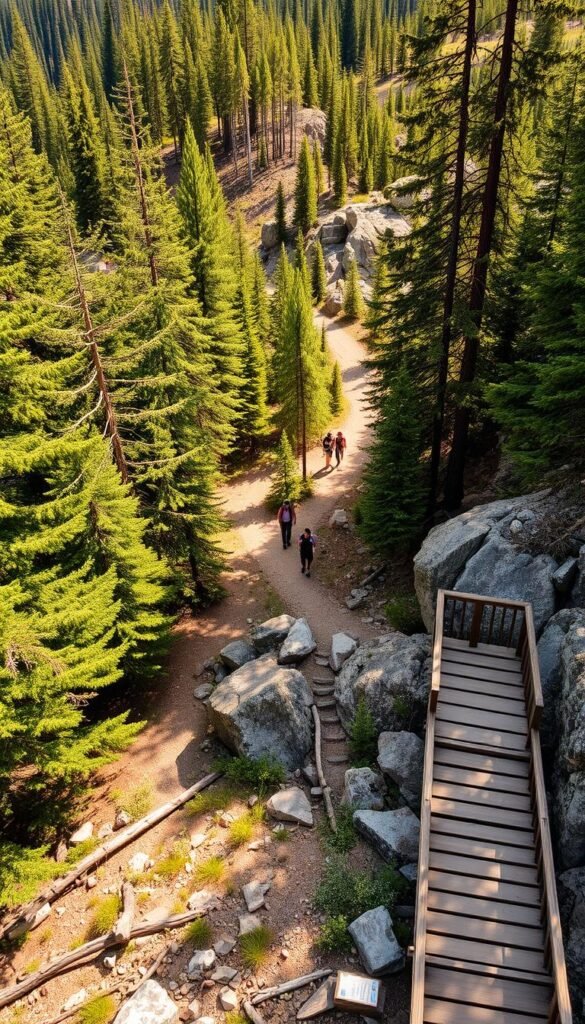
Identifying Key Hiking Trails
Start by asking: Do you want geothermal theatrics or silent forests? For geyser gazing, the Fairy Falls Trail delivers Grand Prismatic Spring overlooks without midday crowds. Prefer wildlife? The Lamar Valley’s Specimen Ridge Trail offers prime bison sightings at golden hour.
| Trail Name | Distance | Difficulty | Best Time |
|---|---|---|---|
| Mystic Falls Loop | 3.5 miles | Moderate | Early Summer |
| Pebble Creek Route | 9.2 miles | Strenuous | Late August |
| Storm Point Trail | 2.3 miles | Easy | Spring Dawn |
First-timers often thrive on the family-friendly hikes in national parks like Yellowstone’s Trout Lake—short enough for kids, scenic enough for photographers. Backcountry enthusiasts should study bear activity reports before tackling isolated routes like Thorofare Trail.
Timing Your Visit Effectively
July’s wildflowers come with crowds—I prefer September’s crisp air when elk bugle near Dunraven Pass. Daily rhythms matter too: thermal areas steam less in morning light, revealing vibrant pool colors. Midday? Perfect for shaded forest walks along Lewis River.
Snowmelt transforms trails in May, while October’s first frost paints the landscape amber. Rangers update trail conditions daily—check visitor centers before committing. Remember: planning trip Yellowstone adventures means preparing for thunderstorms that roll in faster than bison herds charge.
Essential Hiking and Outdoor Tips
Crunching gravel underfoot, I adjust my pack straps—a ritual that signals both anticipation and responsibility. Yellowstone’s wild spaces demand respect, but reward preparedness with moments money can’t buy. These tips bridge safety and wonder, forged through years of navigating the park’s unpredictable terrain.
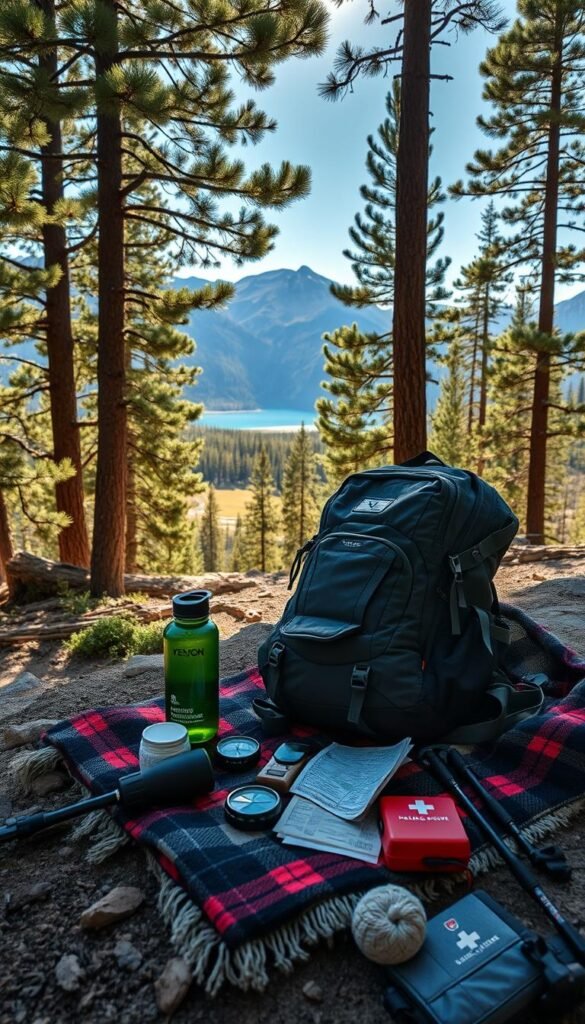
Trail Safety Essentials
Carrying bear spray feels awkward until you lock eyes with a 600-pound bison blocking your path—mine now stays clipped to my belt. Rangers recommend treating every trail intersection like a crosswalk: pause, look, listen. Check weather apps religiously, but trust your boots more—sudden storms turn paths into streams within minutes.
Three non-negotiables I’ve learned:
- Download offline maps (cell service vanishes past trailheads)
- Wear blaze orange during hunting seasons
- Never approach thermal pools—ground can collapse
What to Pack for a Hike
My pack’s secret weapon? A zip-top bag with moleskin strips and electrolyte tabs—saves blistered feet and energy crashes. Layer like an onion: moisture-wicking base, insulating mid, waterproof shell. Sturdy boots matter more than brand names; mine have traction patterns deep enough to hold river pebbles.
Adventure essentials checklist:
- Collapsible water filter (lighter than bottled water)
- Compass and GPS watch (technology fails)
- High-calorie snacks (think jerky, nuts, dark chocolate)
- Headlamp with red-light mode (preserves night vision)
Remember: every ounce counts when miles stretch longer than expected. The national park reveals its magic to those who walk prepared but stay open to surprise—like the time marmots stole my lunch but led me to a hidden waterfall.
Seasonal Considerations and Weather
A sudden snow flurry gives way to sunshine, illuminating a bison calf’s first wobbly steps—this is spring in Yellowstone, where weather and wildlife write the day’s script. The park’s lower elevations burst to life in May, with elk calves testing gangly legs and ospreys rebuilding nests near Fishing Bridge. Rangers reported 412 bison births last spring—a record since 2018.
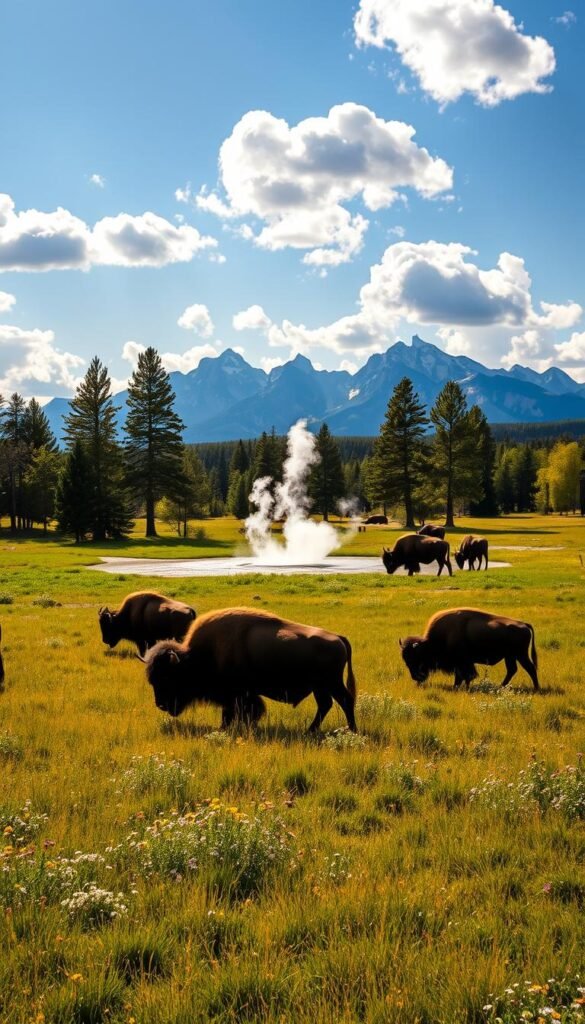
Spring’s Living Theater
Dawn patrols reward early risers with fox kits tumbling near Tower Fall and black bear cubs scaling pine trees. Midday brings animals to open meadows—but watch for sudden temperature drops. I once photographed a wolf pack hunting in sunshine, only to retreat minutes later from marble-sized hail.
Dressing for Nature’s Mood Swings
Spring in Yellowstone National Park demands tactical layering. My go-to system:
- Merino wool base layer (wicks sweat during rapid temperature shifts)
- Windproof softshell (blocks gusts near thermal areas)
- Packable puffer (stuffs into fist-sized pouch)
Trail conditions swing from slush to sunshine hourly. Last April, I trudged through knee-deep snow on the Blacktail Plateau Drive at dawn, then hiked in shirtsleeves by noon. Rangers recommend waterproof boots with aggressive tread—meltwater turns paths into obstacle courses.
Carry microspikes until June at higher elevations. Trust me—they’ve saved my ankles more times than bear spray ever has. Spring’s chaos reveals Yellowstone’s raw beauty, but only to those ready for its mercurial heart.
Must-See Natural Attractions
Watching steam curl into the dawn sky, I realize Yellowstone’s geothermal wonders aren’t just sights—they’re symphonies of earth’s raw power. The park’s iconic features demand strategic timing to witness their full glory, blending science with pure spectacle.
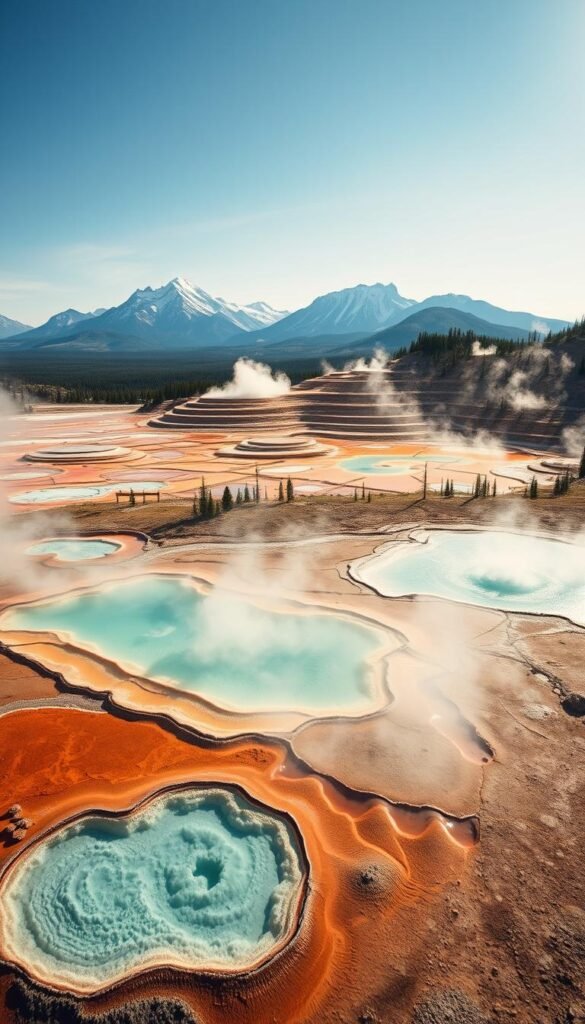
Exploring Old Faithful and Geyser Basins
Old Faithful erupts every 90 minutes like clockwork—but arrive 20 minutes early for front-row seats. Rangers track predictions on visitor center boards, though I prefer watching from Observation Point Trail. This elevated perch avoids crowds while framing eruptions against distant peaks.
Nearby geyser basins simmer with hidden drama. Midway Basin’s turquoise pools glow fiercest under midday sun, while Biscuit Basin’s sapphire springs shimmer through morning mist. Stay on boardwalks—ground temperatures here could melt soles.
Grand Prismatic Spring and Canyon Views
America’s largest hot spring resembles a liquid rainbow—its 370-foot span radiates blues, greens, and fiery oranges. For the iconic aerial views, hike Fairy Falls Trail at solar noon when steam thins. Autumn visits add golden aspen frames to the scene.
The Grand Canyon of the Yellowstone National Park reveals cliffs stained ochre and crimson by mineral runoff. Artist Point dazzles at sunset, but Brink of Lower Falls Trail lets you feel the thunder. Listen for peregrine falcons screeching above the 308-foot cascade.
These landmarks define the park’s soul—not just for their scale, but how they change with light and season. Come prepared with wide-angle lenses, patience, and layers. Nature’s greatest shows reward those who sync with its rhythm.
Wildlife Watching Guidelines
A bull elk’s bugle echoes through the mist—a primal reminder that we’re guests in Yellowstone’s wild kingdom. Observing wildlife here requires equal parts reverence and strategy. I’ve learned that magical encounters happen when we respect boundaries while mastering nature’s rhythms.
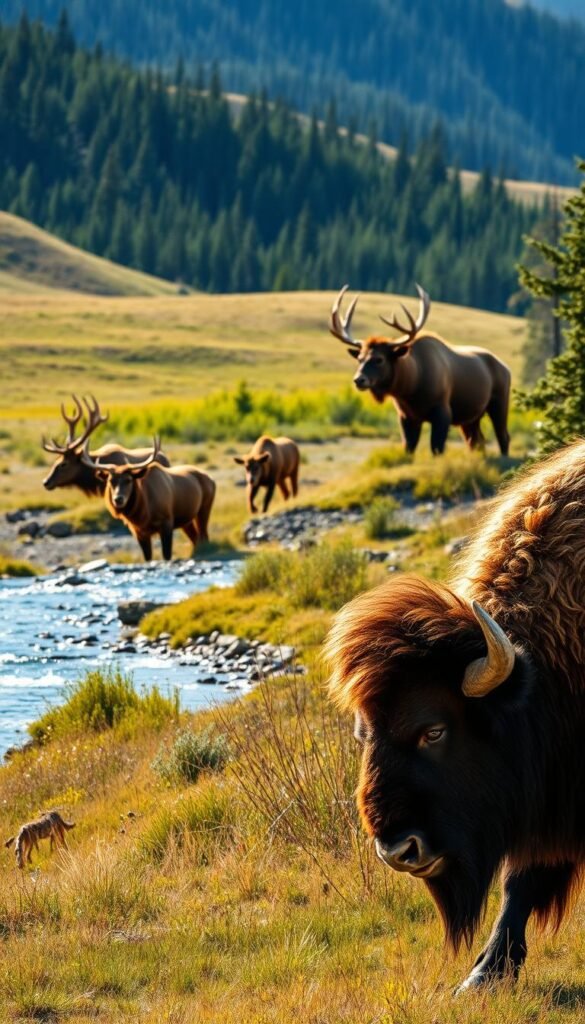
Bear Safety Practices
My bear spray once saved me from a curious black bear near Pelican Valley—now I treat it like a sixth finger. Always carry it unholstered in high-risk zones. Rangers recommend hiking in groups of three; statistics show groups encounter 71% fewer aggressive animals.
Three non-negotiable rules:
- Store food in bear-proof containers—never in tents
- Make noise on blind curves (try singing show tunes)
- Back away slowly if within 100 yards—never run
Best Times for Wildlife Spotting
Dawn transforms Lamar Valley into nature’s theater. Last spring, I counted 23 wolves hunting at sunrise—their silhouettes dancing against frost-kissed grass. Midday heat sends wildlife to shaded areas, but late afternoons revive activity near water sources.
| Season | Key Species | Viewing Zones | Pro Tip |
|---|---|---|---|
| Spring | Bison calves | Hayden Valley | Use binoculars near thermal areas |
| Summer | Elk herds | Madison River | Avoid midday crowds |
| Fall | Bull elk | Mammoth Hot Springs | Listen for antler clashes |
Beat the crowds by arriving 90 minutes before sunrise—you’ll share trails only with mist and anticipation. Evening light near Fishing Bridge often reveals otters playing while most visitors dine. Remember: patience rewards more than proximity in this national park.
Planning Your Itinerary and Travel Logistics
Unfolding my trail map across the picnic table, I trace routes that transform squiggly lines into stories waiting to unfold. Efficient trip design here isn’t about ticking boxes—it’s choreographing days where geothermal wonders and wildlife encounters flow like the Yellowstone River. Let’s turn logistics into liberation.
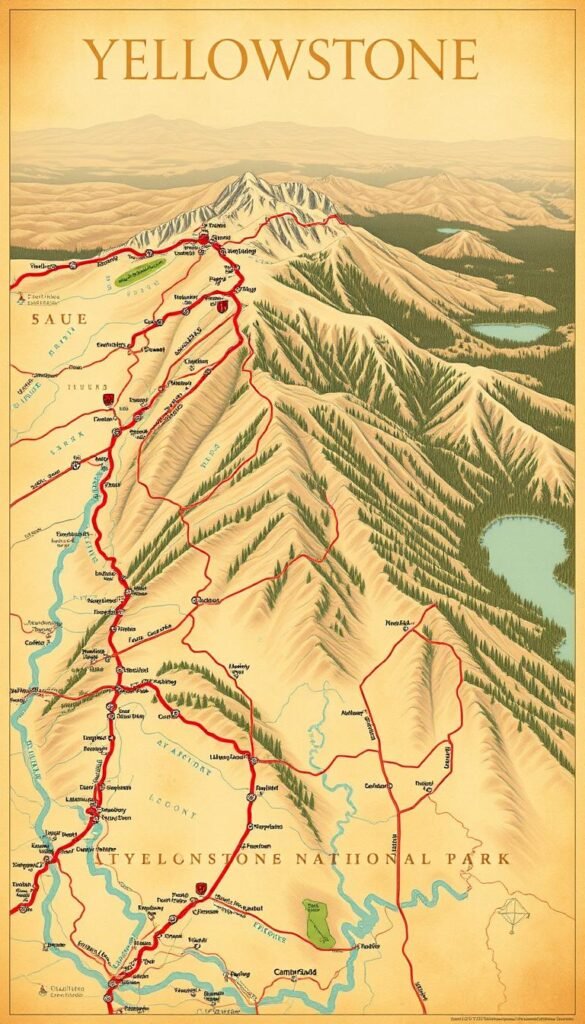
Mapping Routes and Sample Itineraries
Start by circling must-see spots on maps, then connect them like constellations. My favorite three-day loop balances iconic sights with hidden valleys:
| Day | Route | Miles | Highlights |
|---|---|---|---|
| 1 | Norris to Canyon | 38 | Artist Paint Pots, Gibbon Falls |
| 2 | Canyon to Lake | 27 | Mud Volcano, Pelican Valley |
| 3 | Lake to Old Faithful | 42 | West Thumb, Kepler Cascades |
Switch lodging locations mid-trip to slash drive times. Staying at Canyon Village cuts 90 minutes from Lamar Valley sunrise missions compared to West Yellowstone hotels. Always add 30% buffer time—bison jams are nature’s traffic lights.
Digital maps help, but ranger stations offer paper versions revealing trail nuances. My worn 2017 National Park Service map still shows secret hot springs most apps miss. Track daily miles religiously—what feels manageable at home becomes epic when altitude and bear spray weight factor in.
Remember: the best planning trip Yellowstone strategies leave room for detours. That unmarked trail? It once led me to a meadow where wolves howled at twilight. Your map isn’t just directions—it’s the first page of your adventure.
Lodging, Camping, and Accommodations
The scent of pine smoke mingles with steam from nearby hot springs as I collapse into a rocking chair at Old Faithful Inn—this is Yellowstone’s sweet spot between wilderness and comfort. Choosing where to rest your head here shapes your trip Yellowstone experience as much as trail selections.
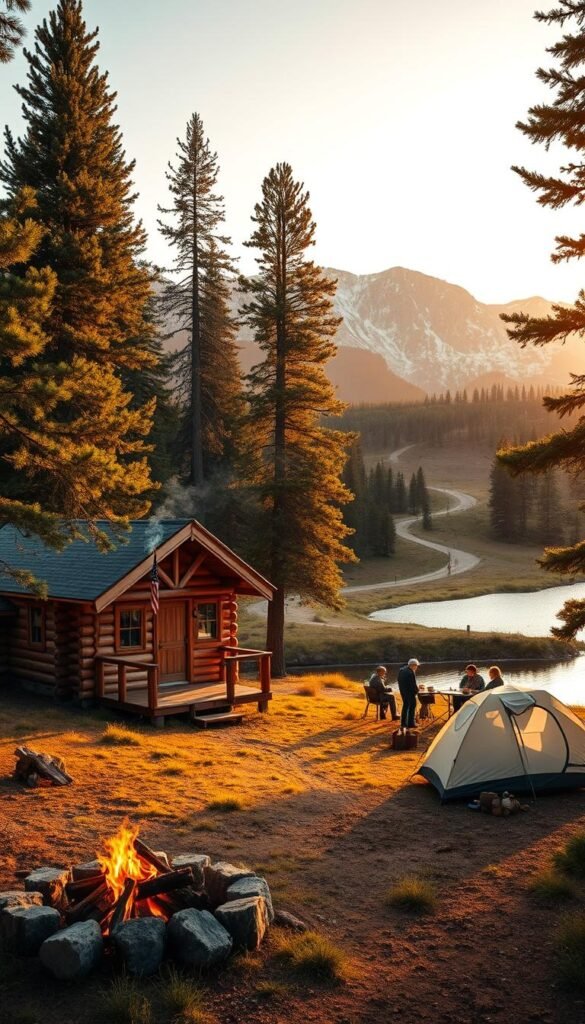
Historic Lodges and Campsite Recommendations
Sleeping in the park’s century-old lodges feels like time travel. The Old Faithful Inn’s timbered lobby hosts geyser-gazing sessions, while Mammoth Hot Springs Hotel offers front-row seats to elk herds grazing near terraces. For campers, Madison Campground’s riverside sites hum with evening wolf choruses.
| Accommodation | Type | Location | Perks |
|---|---|---|---|
| Old Faithful Inn | Lodge | Geyser Basin | Eruption views from balcony |
| Roosevelt Lodge Cabins | Cabins | Tower-Roosevelt | Horseback ride access |
| Canyon Campground | Tents/RVs | Grand Canyon Area | Stargazing programs |
| West Yellowstone KOA | Glamping | West Yellowstone | Heated pools & Wi-Fi |
Reservation and Booking Tips
Securing lodging here requires ninja-level timing. Xanterra releases Yellowstone National Park lodge rooms 13 months ahead—set calendar alerts for 8 AM MT on release days. Campgrounds like Norris accept reservations six months prior, but Mammoth Hot’s first-come sites reward early arrivals.
| Tip | When to Book | Pro Hack |
|---|---|---|
| Historic Lodges | 13 months out | Request upper-floor rooms for quiet |
| Campgrounds | 6 months out | Target Sunday arrivals for openings |
| West Yellowstone Hotels | Winter for summer | Bundle with tour packages |
Always check cancellation policies—I’ve snagged last-minute Canyon Village suites when others canceled. Remember: even a basic tent under the park’s star-blanketed sky beats five-star hotels elsewhere.
Navigating Yellowstone’s Park Facilities
The crisp scent of trail maps mingles with pine-scented air as I push through the visitor center doors—Yellowstone’s facilities transform logistics into launchpads for discovery. Rangers here don’t just hand out maps; they share whispered secrets about hidden geysers and sunrise wolf sightings.

Using Park Stores and Visitor Centers
Time your first stop at a park service hub like Old Faithful or Canyon Village. Staff update whiteboards hourly with road closures and animal activity—last week’s tip saved me from a bison-jammed route near Tower Fall. Grab free topographic maps marked with ranger-approved shortcuts.
| Visitor Center | Hours | Distance from Entrance | Key Services |
|---|---|---|---|
| West Thumb | 9 AM – 5 PM | 17 miles (West) | Fishing permits, bear can rentals |
| Mammoth Hot Springs | 8 AM – 7 PM | 5 miles (North) | Backcountry passes, weather alerts |
| Grant Village | 10 AM – 6 PM | 31 miles (South) | Shuttle tickets, emergency radios |
Park stores stock essentials most forget—like altitude-adjusted matches and pocket-sized geyser prediction charts. I always snag the “Yellowstone National Park Road Guide” for its mile-by-mile thermal feature commentary. Need gas? Service stations sit every 20-30 miles—fill up at Fishing Bridge before exploring Pelican Valley’s dirt roads.
Distance between West Thumb and the East entrance stretches 52 miles, but rangers suggest breaking it up with LeHardy Rapids’ boardwalk. Let these hubs enhance your adventure—they’re more than pit stops; they’re compass points in Yellowstone’s wild narrative.
Guided Tours and Expert Recommendations
Ranger hats bob through the mist as our group huddles near Sapphire Pool—suddenly, boiling water arcs skyward in a liquid ballet only park service interpreters can decode. Joining guided experiences here isn’t just convenient—it’s like borrowing a master key to Yellowstone’s best-kept secrets.
Ranger-Led Programs and Naturalist Hikes
Last summer’s “Geyserology 101” walk transformed my understanding of thermal basins. Our guide revealed how bacteria create Grand Prismatic’s rainbow hues—science I’d never grasp from trail signs alone. These tours peel back layers most visitors miss, like identifying wolf tracks near Hellroaring Creek or decoding elk vocalizations.
| Tour Type | Duration | Focus | Best For |
|---|---|---|---|
| Geyser Gazers | 2 hours | Hydrothermal Systems | Families |
| Wildlife Walks | 4 hours | Animal Behavior | Photographers |
| Photo Tours | Dawn/Dusk | Landscape Lighting | Enthusiasts |
I’ll never forget crouching in Hayden Valley with a retired biologist—her whispered commentary turned distant bison dots into a drama of herd dynamics. These activities transform random sightings into stories you’ll retell for years.
Planning tip: Book park service programs early—spots fill faster than Old Faithful’s eruption schedule. Evening “Star Talks” at Madison Junction remain my secret weapon for avoiding crowds while soaking in galactic views.
Additional Activities beyond Hiking
As the morning mist lifts from Yellowstone Lake, I cast my line into waters mirroring the sky—a different kind of wilderness conversation begins. While trails dominate most itineraries, the park’s magic reveals itself through quieter pursuits too. Let’s swap hiking boots for fishing waders and steering wheels.
Fly Fishing and Scenic Drives
Yellowstone’s rivers hum with native cutthroat trout during summer mornings. My go-to spot? The Madison River’s riffles near West Entrance—shallow enough for beginners, teeming with fish for experts. Pack polarized sunglasses to spot rising trout and a quick-dry hat for sudden showers.
Scenic drives unlock geothermal drama without sweat equity. Cruise Firehole Canyon Drive at dusk to see steam plumes backlit by sunset—like nature’s smoke signals. Keep binoculars handy for roadside wildlife: I once counted seven elk herds between Mammoth and Tower Junction.
For winter adventure, guided snowmobile tours near Old Faithful transform the landscape into a frosted wonderland. Guides share thermal area secrets while you weave through snow-dusted pines—a thrilling alternative to summer’s crowds.
- Yellowstone Lake kayak rentals (available June-September)
- Bear-proof cooler essentials for lakeside picnics
- Roadside geyser pullouts with timetables
These activities prove you don’t need boots to bond with this wild place. Sometimes the best travel moments happen when you’re still—like the day a bald eagle stole my catch, reminding me who rules these skies.
Planning Your Visit: Local Tips and Tricks
Morning light paints the Biscuit Basin boardwalk gold—my favorite hour to wander without jostling for space. Yellowstone’s magic amplifies when you dodge the midday masses. Let me share secrets I’ve gathered from rangers and countless dawn patrols.
Mastering the Clock and Calendar
Old Faithful erupts 20 times daily—but 92% of visitors cram into midday slots. Arrive at 7:30 AM for front-row seats with coffee-steam companions. September mornings offer similar solitude, with elk bugling replacing RV engines.
| Season | Crowd Level | Hidden Perks | Pro Move |
|---|---|---|---|
| May | Low | Bison calves | Thermal views without steam obstruction |
| July | Peak | Wildflowers | Focus on summer trails near Shoshone Lake |
| October | Moderate | Fall colors | Photograph Grand Prismatic without jackets in frame |
Local guides whisper about “shoulder hours”—60 minutes after sunrise and before sunset. These windows gift you Lamar Valley’s wolf packs hunting in amber light, or Mystic Falls’ cascades glowing like liquid mercury.
Three crowd-beating tactics I swear by:
- Use park service webcams to check lot occupancy
- Picnic at lesser-known spots like Grebe Lake
- Reverse popular routes (hike Upper Falls to Canyon midday)
Winter transforms the national park into a snow globe—snowcoach tours glide past geysers with just bison tracks as company. February’s Firehole Canyon drives feel like your private thermal wonderland.
Conclusion
Dust swirls around my boots as I pause near Mammoth Hot Springs—a final reminder that every step here writes its own story. Crafting your experience demands equal parts preparation and wonder, blending trail wisdom with room for serendipity.
Secure lodging early—whether historic lodges near geyser basins or West Yellowstone cabins. Pair iconic stops like Old Faithful with hidden gems: dawn wolf watches in Lamar Valley or twilight dips in Boiling River. Snowmobile tours transform winter landscapes into private wonderlands, while summer’s golden hours unveil prismatic spring views few witness.
Pack bear spray alongside curiosity. Let ranger-led tours decode geothermal secrets, then wander solo to find your rhythm. For deeper insights, our Yellowstone trip planning guide sharpens logistics without dimming adventure’s spark.
The true magic? How bison jams become meditations, and storm clouds paint canyon walls in temporary masterpieces. Your trip isn’t just a checklist—it’s a conversation with wildness. Now lace up, breathe deep, and let Yellowstone’s whispers guide you.

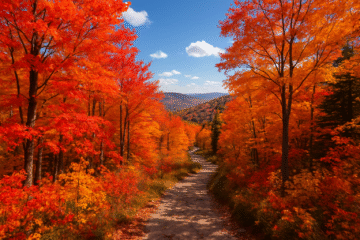
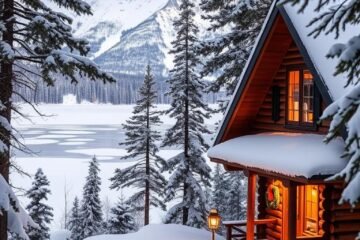
0 Comments